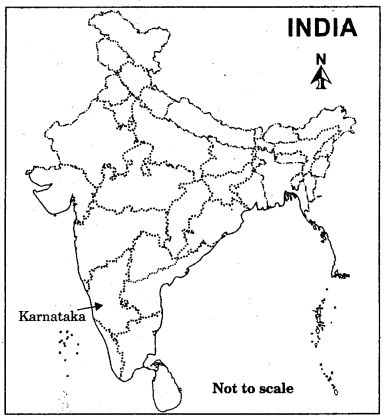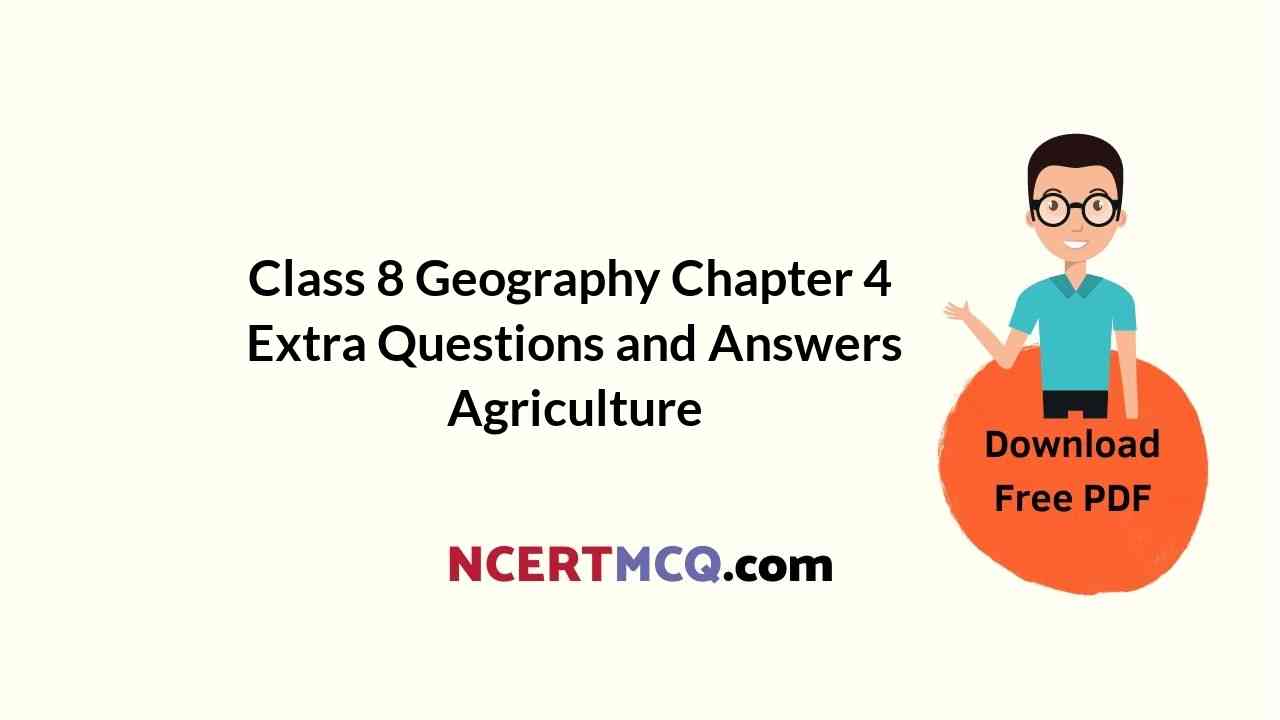Check the below Online Education NCERT MCQ Questions for Class 8 Geography Chapter 4 Extra Questions and Answers Agriculture Pdf free download. https://ncertmcq.com/extra-questions-for-class-8-social-science/
Online Education for Agriculture Class 8 Extra Questions Geography Chapter 4
Class 8 Geography Chapter 4 Extra Questions And Answers Question 1.
What is arable land?
Answer:
The land on which the crops are grown is called arable land.
Agriculture Class 8 Extra Questions Question 2.
Mention the important inputs of agriculture.
Answer:
Seeds, fertilizers, machinery and labour.
Ncert Class 8 Geography Chapter 4 Extra Questions Question 3.
Name the operations involved in agriculture.
Answer:
Ploughing, sowing, irrigation, weeding and harvesting.
Class 8 Geography Chapter 4 Agriculture Extra Questions Question 4.
Mention the outputs of agriculture.
Answer:
Crops, wool, dairy and poultry products.
Class 8 Geography Chapter 4 Extra Questions Question 5.
On what basis can agriculture be classified.
Answer:
- Geographical conditions,
- demand of produce,
- labour,
- level of technology.
Ncert Solutions For Class 8 Geography Chapter 4 Extra Questions Question 6.
Name two major types of farming.
Answer:
- Subsistence farming
- Commercial farming.
![]()
Class 8 Agriculture Extra Questions Question 7.
What is subsistence farming?
Answer:
Subsistence farming is practised to meet the needs of the farmer’s family.
Agriculture Class 8 Questions And Answers Question 8.
Into which two types can subsistence farming be classified?
Answer:
- Intensive subsistence,
- Primitive subsistence farming.
Extra Questions For Class 8 Geography Chapter 4 Question 9.
Name the crops cultivated in intensive subsistence agriculture.
Answer:
Wheat, maize, pulses and oilseeds.
Geography Class 8 Chapter 4 Extra Questions Question 10.
Into which two types can primitive subsistence agriculture be divided?
Answer:
- Shifting cultivation,
- nomadic herding.
Chapter 4 Geography Class 8 Extra Questions Question 11.
In which parts of the world is shifting cultivation practised?
Answer:
- Amazon basin,
- Tropical Africa,
- Parts of South-East Asia,
- North-East India.
Class 8 Geography Ch 4 Extra Questions Question 12.
Which types of farming are included in commercial farming?
Answer:
- Commercial grain farming,
- Mixed farming,
- Plantation agriculture.
Extra Questions Of Agriculture Class 8 Question 13.
In the temperate grasslands of North America, why can only a single crop be grown?
Answer:
In the temperate grasslands of North America, only a single crop can be grown because severe winters- restrict the growing season.
![]()
Agriculture Class 8 Extra Questions And Answers Question 14.
Name two major plantations found in the tropical regions of the world.
Answer:
- Rubber plantation in Malaysia
- Coffee plantation in Brazil
- Tea plantation in India and Sri Lanka.
Extra Questions On Agriculture Class 8 Question 15.
Name two important food crops, fibre crops and beverage crops.
Answer:
- Food crops – wheat,
- rice Fibre crops – jute,
- cotton Beverage crops – tea, coffee.
Class 8 Geography Agriculture Extra Questions Question 16.
Name four leading producers of rice.
Answer:
China, India, Japan, Sri Lanka.
Agriculture Extra Questions Class 8 Question 17.
Name two places where two to three crops of rice are grown in a year.
Answer:
- West Bengal,
- Bangladesh.
Agriculture Class 8 Geography Extra Questions Question 18.
During which season is wheat grown in India?
Answer:
Winters.
Extra Questions Of Chapter 4 Geography Class 8 Question 19.
Name the leading producers of maize.
Answer:
North America, Brazil, China, Russia, Canada, India and Mexico.
Class 8 Chapter 4 Geography Extra Questions Question 20.
In which countries is cotton grown as a major crop?
Answer:
China, USA, India, Pakistan, Brazil and Egypt.
Question 21.
Which countries produce best quality tea in the world?
Answer:
Kenya, India, China, Sri Lanka.
![]()
Question 22.
What are primary activities? Give examples.
Answer:
Primary activities include all those activities connected with extraction and production of natural resources. For example, agriculture, fishing, gathering etc.
Question 23.
What are secondary activities? Give examples.
Answer:
Secondary activities are concerned with the processing of natural resources. For example, manufacturing of steel, weaving of cloth etc.
Question 24.
What are tertiary activities? Give examples.
Answer:
Tertiary activities provide support to the primary and secondary sectors through services. For example, trade, banking, insurance etc.
Question 25.
In which parts of the world is nomadic herding practised?
Answer:
Nomadic herding is practised in the following regions –
- Semi-arid and arid regions of Sahara.
- Central Asia.
- Rajasthan and Jammu and Kashmir in India.
![]()
Question 26.
Write the main features of commercial farming?
Answer:
Main features of commercial farming are:
- Crops are grown and animals are reared for sale in the market.
- The area cultivated and the amount of capital used is large.
- Most of the work is done by machines.
Question 27.
What is mixed farming? In which parts of the world is it practised?
Answer:
- In the mixed farming, the land is used for growing food and fodder crops and rearing livestock.
- It is practised in Europe, Eastern USA, Argentina, Southeast Australia, New Zealand and South Africa.
Question 28.
Why do is development of a transport network essential for plantation farming?
Answer:
Development of a transport network is essential for plantation farming because the produce is processed on the farm itself or in nearby factories.
Question 29.
Mention the geographical requirements for the cultivation of rice.
Answer:
- It is mainly grown in tropical and sub-tropical regions.
- Rice needs high temperature, high humidity and rainfall.
- It grows well in alluvial clayey soil.
Question 30.
Write the geographical requirements for wheat cultivation.
Answer:
- Wheat requires moderate temperature and rainfall during growing season and bright sunshine at the time of harvest.
- It thrives best in well-drained loamy soil.
Question 31.
Mention the geographical conditions required for maize cultivation.
Answer:
- Maize requires moderate temperature.
- It also needs well-drained fertile soils.
![]()
Question 32.
Write the geographical conditions required for cotton.
Answer:
- Cotton requires high temperature, light rainfall, two hundred and ten frost-free days and bright sunshine.
- It grows best on black and alluvial soils.
Question 33.
Mention the geographical conditions required for coffee cultivation.
Answer:
- Coffee requires warm and wet climate and well-drained loamy soil.
- Hill slopes are more suitable for the growth of this crop.
Question 34.
What is agricultural development? Also, write its ultimate aim.
Answer:
- Agricultural development refers to the efforts made to increase farm production in order to meet the growing demand of increasing population.
- Its ultimate aim is to increase food security.
Question 35.
How can farm production be increased?
Or
How can the ultimate aim of agricultural development be increased?
Answer:
Farm production can be increased in the following ways –
- Increasing the cropped area.
- The number of crops grown.
- Improving irrigation facilities.
- Use of fertilizers and high yielding variety of seeds.
![]()
Question 36.
On the outline map of India show the following places. Coffee producing state.
Answer:
Coffee producing state

Question 37.
What is sericulture? Name the factors influencing agriculture?
Answer:
Commercial rearing of silkworms is called sericulture. Factors influencing agriculture are as follows :
- Favourable topography
- Soil
- Climate.
Question 38.
Write the main features of intensive subsistence agriculture.
Answer:
- The farmer cultivates a small plot of land using simple tools and more labour.
- Climate with large number of days with sunshine and fertile soil permit growing of more than one crop annually on the same field.
- Major crops grown are rice, wheat, maize, pulses etc.
- Intensive subsistence agriculture is practised in thickly populated areas of the monsoon regions of South, South-East and East Asia.
Question 39.
Write the main features of nomadic herding.
Answer:
- Herdsmen move from place to place with their animals in search of fodder and water.
- Herders have to move from one place to another due to climatic constraints and terrain.
- Sheep, camel, cattle, yak and goats are the most commonly reared.
- Animals provide milk, meat, wool, hides and other products to herders and their families.
Question 40.
Describe the regions where commercial grain farming is practised.
Answer:
- Commercial grain farming is practised in the temperate grasslands of North America, Europe and Asia.
- These regions are sparsely populated with large farms spreading over hundreds of hectares.
- Due to severe winters, only a single crop can be grown.
![]()
Question 41.
Write a short note on millets.
Answer:
- Millets are also known as coarse grains and can be grown on less fertile and sandy soils.
- It is a hardy crop that needs low rainfall and high to moderate temperature and adequate rainfall.
- Millets are grown in India, Nigeria, China and Niger.
Question 42.
Write the geographical condi¬tions required for the cultivation of tea.
Answer:
- Tea requires cool climate and well-distributed high rainfall throughout the year for the growth of its tender leaves.
- It needs well-drained loamy soils and gentle slopes.
- Large number of labour is required to pick the leaves.
Multiple Choice Questions (MCQs)
1. ………………………….. is not a tertiary activity.
(a) Trade
(b) Manufacturing
(c) Transport
(d) Banking.
Answer:
(b) Manufacturing
2. Tick the odd pair in the following.
(a) Pisciculture – breeding of fish.
(b) Viticulture – cultivation of grapes.
(c) Horticulture – rearing livestock.
(d) Sericulture – rearing of silkworms.
Answer:
(c) Horticulture – rearing livestock.
3. Organic manure and natural pesticides are used instead of chemicals in this type of farming. What is it called?
(a) Subsistence farming
(b) Shifting cultivation
(c) Mixed farming
(d) Organic farming.
Answer:
(d) Organic farming.
![]()
4. Which of the following crops needs high temperature, high humidity, fertile soil and good rainfall?
(a) Rice
(b) Wheat
(b) Cotton
(d) Millets
Answer:
(a) Rice
5. Which of the following pairs is not correct?
(a) Tea – beverage
(b) Jute – Golden Fibre
(c) Wheat – corn
(d) Millets – coarse grains
Answer:
(c) Wheat – corn
Glossary:
→ Primary activities – They include activities connected with extraction and production of natural resources.
→ Secondary activities – These activities are concerned with the processing of natural resources.
→ Tertiary activities – These activities provide support to the primary and secondary sectors through services.
→ Sericulture – Commercial rearing of silkworms.
→ Viticulture – Cultivation of grapes.
→ Pisciculture – Breeding of fish in specially constructed tanks and ponds.
→ Horticulture – Growing vegetables, flowers and fruits for commercial use.
→ Agriculture – The science and art of cultivation on the soil, raising crops and rearing livestock.
→ Subsistence farming- This type of farming is practised to meet the needs of farmer’s family.
→ Nomadic herding – The herdsmen move from one place to another in search of fodder and water.
→ Commercial farming- The crops are grown and animals are reared for sale in the market.
→ Mixed farming – The land is used for growing food and fodder crops and rearing livestock.
→ Organic farming – The use of organic manure and natural pesticides instead of chemicals is known as organic farming.
→ Agricultural development – It refers to efforts made to increase farm production in order to meet the growing demand of increasing population.
